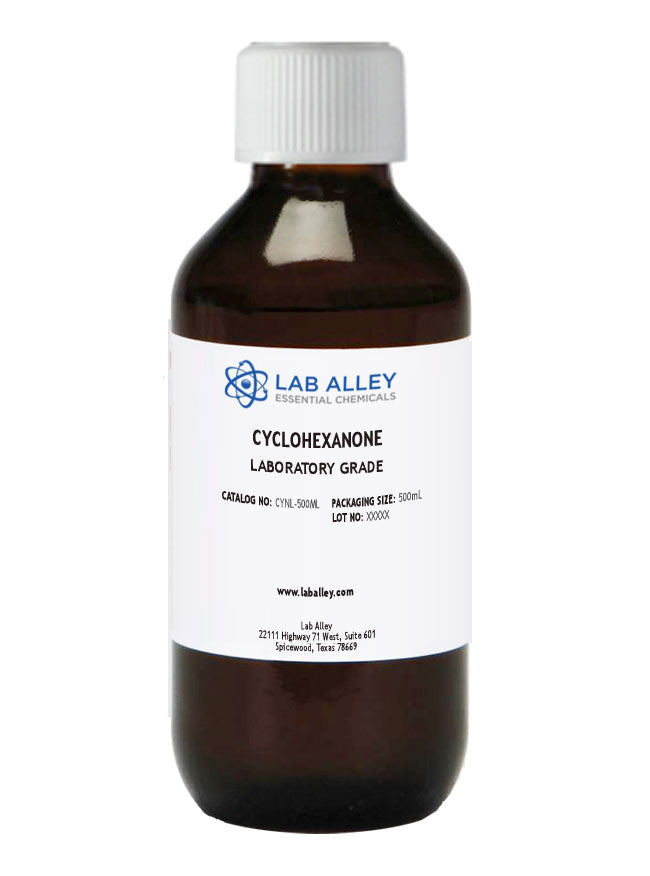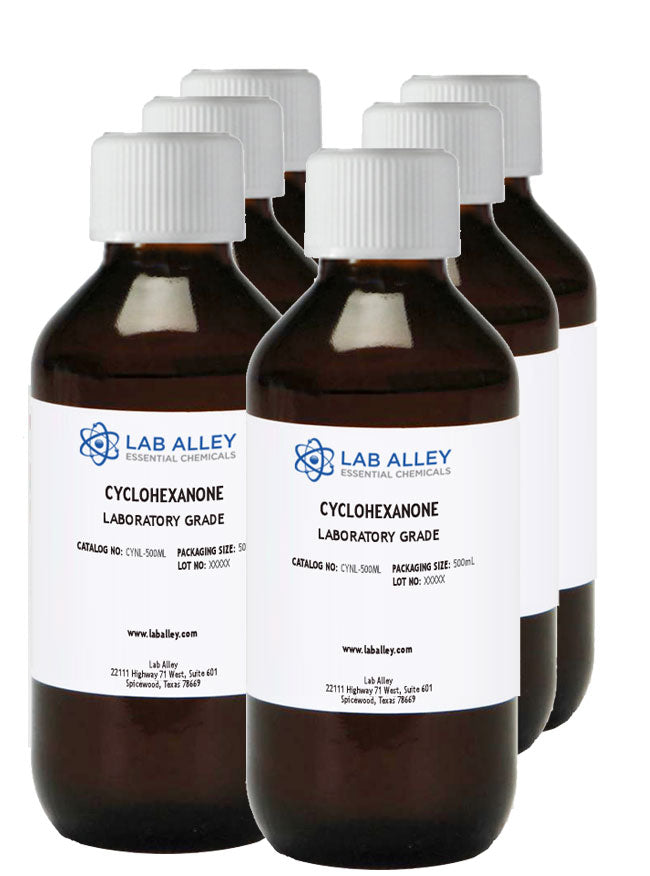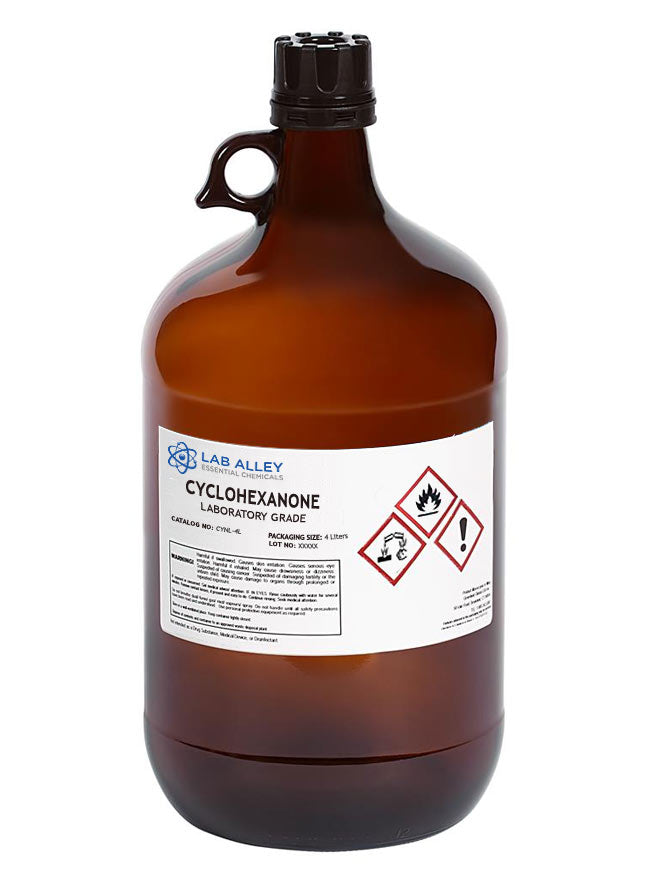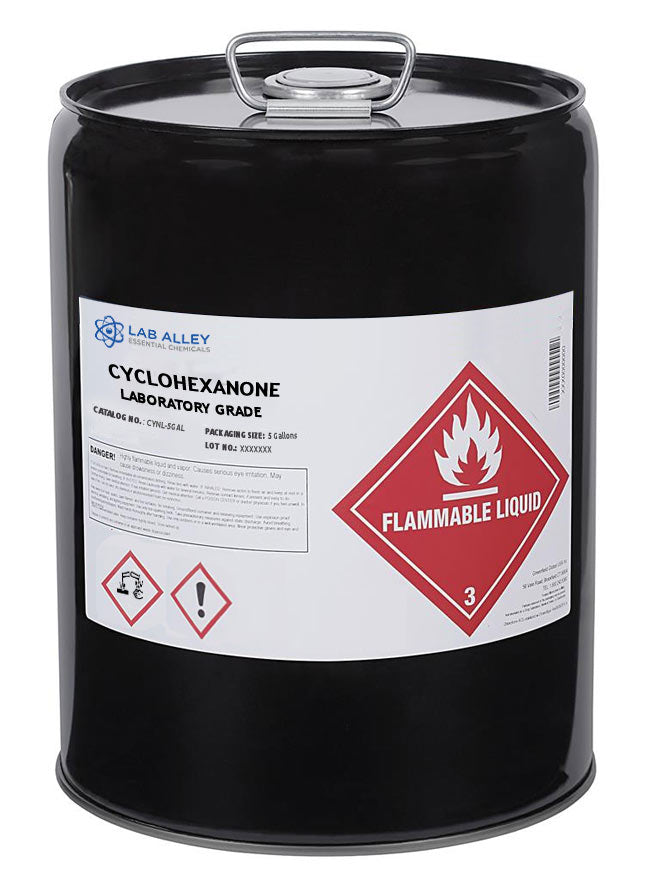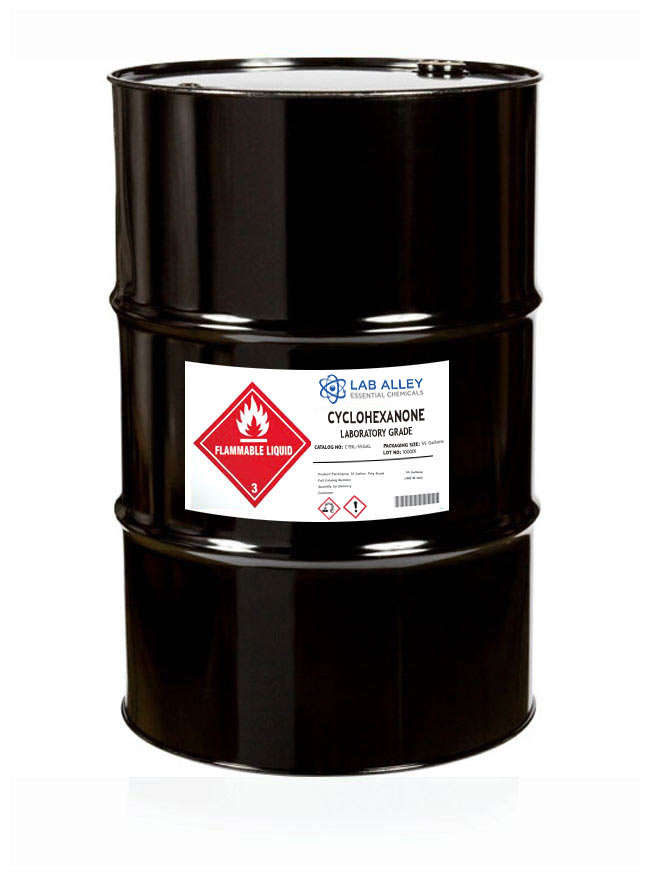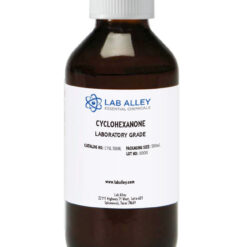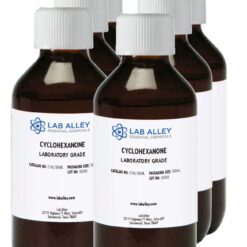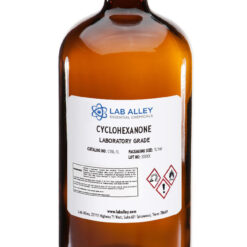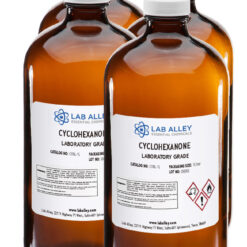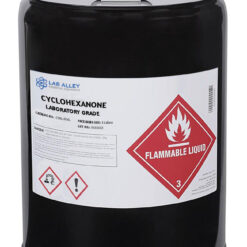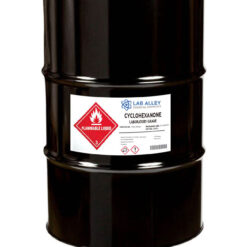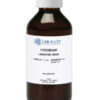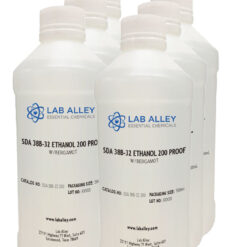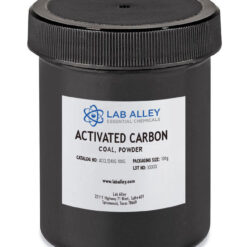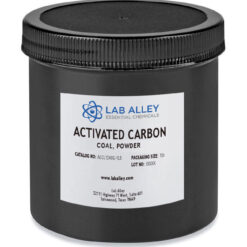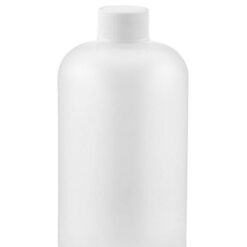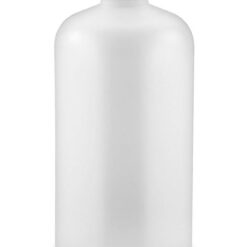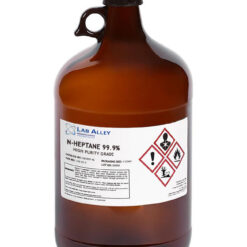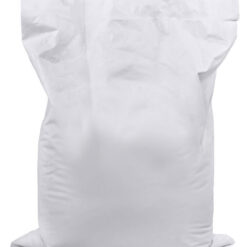Cyclohexanone, Lab Grade
$66.00 – $2,090.00
| 108-94-1 | |
| C6H10O | |
| 98.14 | |
| Ketohexamethylene, Pimelic ketone, Sextone, Cyclohexyl ketone, Nadone, Anone, Anon, Cyclohexanon | |
| 7967 | |
| Lab Grade | |
| NLT 99.0% | |
| Cyclohexanone | |
| 1915 |
Cyclohexanone For Sale Online At LabAlley.com
If you have questions about ordering Cyclohexanone in bulk online here at LabAlley.com or would like to place an order, call 512-887-6087 or email customerservice@laballey.com to talk with a Cyclohexanone specialist.
Information On Cyclohexanone From Wikipedia
Cyclohexanone is the organic compound with the formula (CH2)5CO. The molecule consists of six-carbon cyclic molecule with a ketone functional group. This colorless oil has an odor reminiscent of that of acetone. Over time, samples of cyclohexanone assume a yellow color. Cyclohexanone is slightly soluble in water and miscible with common organic solvents. Billions of kilograms are produced annually, mainly as a precursor to nylon. Read more here.
Cyclohexanone Chemical Properties And Reference Resources
- Cyclohexanone Formula: C6H10O
- Cyclohexanone CAS RN: 108-94-1
- Cyclohexanone Molar Mass: 98.15 g/mol
- Cyclohexanone Boiling point: 312.2°F (155.6°C)
- Cyclohexanone Density: 948 kg/m³
- Cyclohexanone Melting point: -23.8°F (-31°C)
- Cyclohexanone Molecular Weight: 98.15 g/mol
- Cyclohexanone Soluble in: Water
- Cyclohexanone pKa: 16.7
- Cyclohexanone SDS And MSDS: Contact Lab Alley
- Cyclohexanone Safety And Hazards
- Cyclohexanone PubChem CID: 7967
- Cyclohexanone ChemSpider ID: 7679
- Where To Buy Cyclohexanone: LabAlley.com/Products/Cyclohexanone-Reagent
- Cyclohexanone Price Trends
- Cyclohexanone Infrared Spectrum (IR)
- Cyclohexanone Oxime
- Cyclohexanone Forms Cyanohydrin
- Cyclohexanone With Double Bond
- Cyclohexanone With CH3CH2NH2
- Cyclohexanone With NH2OH
- Cyclohexanone With NaOH
- Cyclohexanone With Dimethylamine
- Cyclohexanone With Benzylamine
- Cyclohexanone Formaldehyde Resin
- Cyclohexanone Structure, Properties, Spectra, Suppliers And Links
The great majority of cyclohexanone is consumed in the production of precursors to Nylon 6,6 and Nylon 6. About half of the world’s supply is converted to adipic acid, one of two precursors for nylon 6,6. For this application, the KA oil (see above) is oxidized with nitric acid. The other half of the cyclohexanone supply is converted to cyclohexanone oxime. In the presence of sulfuric acid catalyst, the oxime rearranges to caprolactam, a precursor to nylon 6.
Laboratory Reactions: In addition to the large scale reactions conducted in service of the polymer industry, many reactions have been developed for cyclohexanone. In the presence of light, it undergoes alpha-chlorination to give 2-chlorocyclohexanone. It forms a trimethylsilylenol ether upon treatment with trimethylsilylchloride in the presence of base. It also forms an enamine with pyrolidine.
Illicit Use: Cyclohexanone has been used in the illicit production of phencyclidine and its analogues and as such is often subject to additional checks before purchase. Read more here.
Cyclohexanone Safety And Hazards
Inhalation of vapors from hot material can cause narcosis. The liquid may cause dermatitis. HIGHLY FLAMMABLE: Will be easily ignited by heat, sparks or flames. Vapors may form explosive mixtures with air. Vapors may travel to source of ignition and flash back. Most vapors are heavier than air. They will spread along ground and collect in low or confined areas (sewers, basements, tanks). Vapor explosion hazard indoors, outdoors or in sewers. Those substances designated with a (P) may polymerize explosively when heated or involved in a fire. Runoff to sewer may create fire or explosion hazard. Containers may explode when heated. Many liquids are lighter than water. Flammable. Above 44°C explosive vapor/air mixtures may be formed. Read more here.
Cyclohexanone is produced by the oxidation of cyclohexane in air, typically using cobalt catalysts: C6H12 + O2 → (CH2)5CO + H2O. This process co-forms cyclohexanol, and this mixture, called “KA Oil” for ketone-alcohol oil, is the main feedstock for the production of adipic acid. Read more here.
Cyclohexanone is produced by the oxidation of cyclohexane in air, typically using cobalt catalysts: C6H12 + O2 → (CH2)5CO + H2O. This process co-forms cyclohexanol, and this mixture, called “KA Oil” for ketone-alcohol oil, is the main feedstock for the production of adipic acid. Read more here.
Information On Cyclohexanone From PubChem
Cyclohexanone is a colorless oily liquid with an odor resembling acetone and peppermint. Cyclohexanone is occasionally found as a volatile component of human urine. Biological fluids such as blood and urine have been shown to contain a large number of components, some of them volatiles (low boiling point) apparently present in all individuals, while others such are much more variable. In some cases differences up to an order of magnitude are observed. Although some of these changes may have dietary origins, others seem to be characteristic of the individual. Cyclohexanone is obtained through oxidation of cyclohexane or dehydrogenation of phenol. Approx. 95% of its manufacturing is used for the production of nylon. Information on toxicity to human beings is fragmentary. Acute exposure is characterized by irritation of the eyes, nose, and throat. In two persons, drowsiness and renal impairment were found; however, these workers were also exposed to other compounds. Hepatic disorders were found in a group of workers exposed for over five years. In animals, cyclohexanone is characterized by relatively low acute toxicity (DL50 by intragastric administration is approximately 2 g/kg body wt. ). Effects on the central nervous system (CNS) were found (narcosis), as well as irritation of the eyes and skin. Following multiple administration, effects were found in the CNS, liver, and kidneys as well as irritation of the conjunctiva. Mutagenic and genotoxic effects were found, but no teratogenic effects were detected; however, there were embryotoxic effects and influence on reproduction Cyclohexanone is well absorbed through the skin, respiratory tract, and alimentary tract. The main metabolic pathway leads to cyclohexanol, which is excreted in urine coupled with glucuronic acid. A high correlation was found between the concentration of cyclohexanone in the working environment and its concentration in urine. Cyclohexanone is formed from the hydrocarbons cyclohexane and 1-, 2-, and 3-hexanol. A patient’s case report documents the development of anosmia (an olfactory disorder) and rhinitis caused by occupational exposure to organic solvents, including cyclohexanone. Cyclohexanone appears as a colorless to pale yellow liquid with a pleasant odor. Less dense than water . Flash point 111°F. Vapors heavier than air. Used to make nylon, as a chemical reaction medium, and as a solvent. Cyclohexanone is a cyclic ketone that consists of cyclohexane bearing a single oxo substituent. It has a role as a human xenobiotic metabolite. Read more here.
What Is Cyclohexanone Used For?
Chemical properties and uses of cyclohexanone. It is a raw material for the production of caprolactam and adipic acid, used as a solvent and diluent for paints, inks, synthetic resins, synthetic rubbers, and also used as a degreasing agent for leather, etc. Read more here.
Cyclohexanone Reagent Features:
Cyclohexanone, Lab Grade Features:
| Assay | Min 99.0% |
| Color (APHA) | 10 |
| Residue after Evaporation | 0.05% |
| Water | 0.05% |
DOT: Cyclohexanone, 3, UN1915, PG III, Hazmat Fee Required
| Weight | 907 lbs |
|---|---|
| Model | 500mL, 6 x 500mL Case, 1 Liter, 4 x 1 Liter Case, 4 Liters, 4 x 4 Liters Case, 5 Gallons, 55 Gallons |

